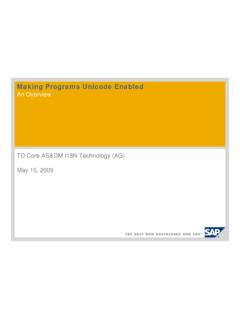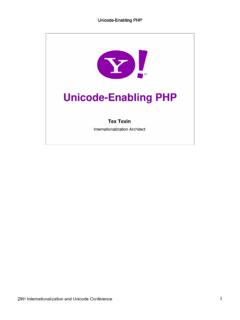Transcription of Obfuscating your code with SmartAssembly
1 Obfuscating your code with SmartAssembly SmartAssembly - Red Gate Software Ltd 2 19 October 2011 Contents Red Gate Software Ltd 3 19 October 2011 The benefits of obfuscation Obfuscating your code with Red Gate's SmartAssembly can help to protect you against intellectual property theft by making your code hard to read. This paper discusses the different forms of obfuscation offered by SmartAssembly and when to use them. Why should I obfuscate my code? Red Gate Software Ltd 4 19 October 2011 Obfuscating type and method names SmartAssembly offers three levels of obfuscation for type names and method names. These are: ASCII characters Renames types and methods using ASCII characters. For example, the type FullScreenSplash might be obfuscated to #dc. Note: You must choose this option if you want to be able to decode stack tracks after obfuscation. Unicode unprintable characters Renames types and methods using Unicode unprintable characters.
2 For example, the type FullScreenSplash might be obfuscated to U+1D11E (which is unprintable). Unicode unprintable characters and advanced renaming algorithm Renames types and methods using Unicode unprintable characters and renames multiple items with the same name. For example, the types FullScreenSplash and FontStyle are both obfuscated to U+017D. Obfuscating field names SmartAssembly also offers three different schemes for renaming field names. These are: One-to-one renaming scheme Changes all fields in all classes so that they have different names. A field's name is unique within an assembly. Note: You must choose this option if you want to be able to retrieve the original field names from stack traces. Standard renaming Alters the field name so that is unique within a class, however the same name is often used within other classes in the assembly. For example, #a: string, #b: boolean, #c: string, #d: boolean.
3 Advanced renaming Alters the field name, however it not unique within a class and is reused. Fields of a different type will have the same name. For example, #a: string, #a: boolean, #b: string, #b: boolean. Obfuscating names Red Gate Software Ltd 5 19 October 2011 Regardless of the renaming scheme chosen, the field name is also obfuscated in the same style as the selected types/methods name obfuscation (ASCII or Unicode unprintable characters). Understanding name obfuscation: example To illustrate the effect of using obfuscation options, this example uses the following code sample, part of the C# source code for a program called QueryBee (a simple WinForms application which can query SQL servers). Code before obfuscation namespace QueryBee { public class ConnectForm : Form { // Fields private IContainer components; private EventHandler Foregrounded; private ComboBox m_ComboDatabase; private ComboBox m_comboServer; private Button m_connectButton; private ProgressBar m_connectProgress; private SystemHotkey m_hotkey; private Label m_labelDatabase; private Label m_labelError; private Label m_labelServer; private NotifyIcon m_trayIcon; private ContextMenuStrip m_traymenu; private ToolStripMenuItem m_trayMenuClose; private ToolStripMenuItem m_trayMenuOpen; // Events public event EventHandler Foregrounded; // Methods public ConnectForm(); private void connectForm_Resize(object sender, EventArgs e).}}
4 Red Gate Software Ltd 6 19 October 2011 protected override void Dispose(bool disposing); private void InitializeComponent(); private void m_comboDatabase_clickIn(object sender, EventArgs e); private void m_ComboDatabase_TextChanged(object sender, EventArgs e); private void m_connectButton_Click(object sender, EventArgs e); private void m_trayIcon_DoubleClick(object sender, EventArgs e); private void m_trayMenuClose_Click(object sender, EventArgs e); private void m_trayMenuOpen_Click(object sender, EventArgs e); protected override bool ProcessCmdKey(ref Message msg, Keys keyData); The code above is obfuscated using SmartAssembly s most basic level of obfuscation: ASCII characters and one-to-one field renaming. To show the effects of this obfuscation on the code, Red Gate s .NET Reflector (a tool which can disassemble .NET executables) can be used to view the result.
5 Code after ASCII character obfuscation namespace #W8z { internal class #V8z : Form { // Fields private EventHandler #58z; private ComboBox #68z; private Label #78z; private ComboBox #88z; private Label #98z; private NotifyIcon #a9z; private Button #b9z; private ProgressBar #c9z; private #Z8z #d9z; private ContextMenuStrip #e9z; private ToolStripMenuItem #f9z; private ToolStripMenuItem #g9z; private Label #h9z; private IContainer #vyc; Red Gate Software Ltd 7 19 October 2011 // Events public event EventHandler Foregrounded; // Methods private void #8I(); private void #I9z(object sender, EventArgs e); private void #J9z(object sender, EventArgs e); private void #K9z(object sender, EventArgs e); private void #L9z(object sender, EventArgs e); private void #M9z(object sender, EventArgs e); private void #N9z(object sender, EventArgs e); private void #O9z(object sender, EventArgs e); public #V8z(); protected override void Dispose(bool disposing); protected override bool ProcessCmdKey(ref Message msg, Keys keyData); By changing the names of these methods (from 'ComboDatabase' to '#68z', for example), it is already much harder to understand the function of this code.}}
6 Note: in the last two lines 'disposing' and 'keyData' have not been obfuscated. This is because SmartAssembly detects when it would be unsafe to obfuscate a name, and leaves names that would break your code if changed. In the example above, the field names ('#58z' and so on) are unique to the class '#V8z', however, and so with some effort it may be possible to work out their functionality. To avoid this, SmartAssembly s standard field renaming function can be applied to reuse the same field names within multiple classes in the assembly. Code after standard field renaming namespace #W8z { internal class #V8z : Form { // Fields private EventHandler #a; private IContainer #b; private ComboBox #c; Red Gate Software Ltd 8 19 October 2011 private Label #d; private ComboBox #e; private Label #f; private NotifyIcon #g; private Button #h; private ProgressBar #i; private #Z8z #j; private ContextMenuStrip #k; private ToolStripMenuItem #l; private ToolStripMenuItem #m; private Label #n.}}
7 Internal class #Y8z : Form { // Fields private readonly SqlConnection #a; private IContainer #b; private TextBox #c; private Button #d; private DataGridView #e; private Panel #f; private ProgressBar #g; private Label #h; private Label #i; The level of obfuscation can be improved still further by replacing the ASCII characters in the names above with unprintable Unicode characters (and symbols). Most names are not displayed at all. Code after obfuscation with Unicode unprintable characters namespace { internal class : Form { Red Gate Software Ltd 9 19 October 2011 // Fields private EventHandler ; private IContainer ; private ComboBox ; private Label ; private ComboBox ; private Label ; private NotifyIcon ; private Button ; private ProgressBar; private ; private ContextMenuStrip ; private ToolStripMenuItem ; private ToolStripMenuItem ; private Label ; // Events public event EventHandler Foregrounded; // Methods public (); private void (); private void (object sender, EventArgs e); private void (object sender, EventArgs e); private void (object sender, EventArgs e).}}}
8 Private void (object sender, EventArgs e); private void (object sender, EventArgs e); private void " (object sender, EventArgs e); private void " (object sender, EventArgs e); protected override void Dispose(bool disposing); Finally, advanced field renaming uses identical names for different fields of different types within the same class. In the example below (which uses ASCII names), the three fields of type 'label' have different names but many fields of different types share the name '#a'. Red Gate Software Ltd 10 19 October 2011 Code after advanced field renaming namespace #W8z { internal class #V8z : Form { // Fields private #Z8z #a; private IContainer #a; private EventHandler #a; private Button #a; private ComboBox #a; private ContextMenuStrip #a; private Label #a; private NotifyIcon #a; private ProgressBar #a; private ToolStripMenuItem #a; private ComboBox #b; private Label #b; private ToolStripMenuItem #b; private Label #c; By combining Unicode unprintable character obfuscation with advanced field renaming, you can greatly reduce the risk of anyone understanding your source code, even after disassembly.}}
9 The result of this level of obfuscation is not shown here because it would be impossible to show that the same unprintable characters are used for multiple field names. Red Gate Software Ltd 11 19 October 2011 Software often stores passwords, login information, licensing information and/or SQL requests in strings. SmartAssembly can encode strings in an assembly to protect them. Choosing this option may affect the performance of the application. To enable strings encoding, select the appropriate options in the strings encoding section of the main project settings window in SmartAssembly . Notes: You cannot use 'strings encoding with improved protection' with .NET , or with any version of Microsoft Compact Framework, Silverlight or XNA. You cannot use 'compress and encrypt the encoded strings' with .NET , Microsoft Compact Framework version 1, Silverlight or XNA. Strings encoding Red Gate Software Ltd 12 19 October 2011 In addition to renaming crucial parts of your code, you can also use SmartAssembly to make your code more difficult to read by making it unnecessarily complex (converting it into 'spaghetti code').
10 Control flow obfuscation prevents most programs from being able to disassemble the code. For example, attempting to disassemble control-flow-obfuscated code using Red Gate's .NET Reflector will give: private static void Main() { // This item is obfuscated and can not be translated. } Note: Using control flow obfuscation can impact the performance of your application; there are three levels of control flow obfuscation in SmartAssembly , which which allow you to balance performance overhead against increased complexity. To enable control flow obfuscation, select the option in the control flow obfuscation section of the main project settings window in SmartAssembly . Note: Control flow obfuscation does not work with any version of Microsoft Compact Framework or XNA. Obfuscating control flow Red Gate Software Ltd 13 19 October 2011 If you make calls outside of your assembly, these calls will still be visible in your code after string encoding and control flow obfuscation.









